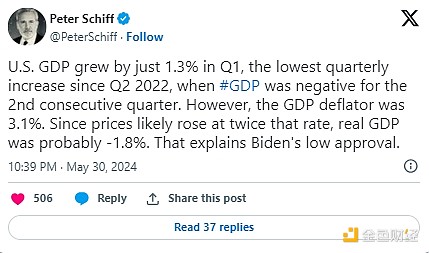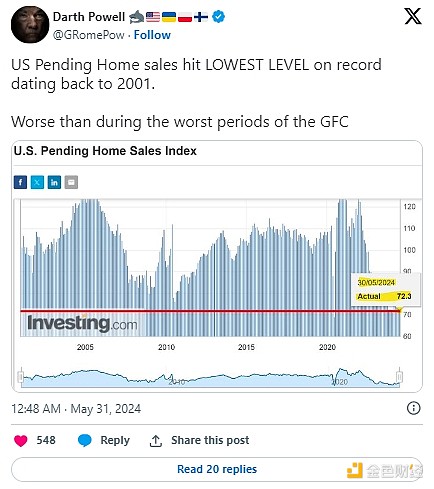Author: Jack Inabinet, Bankless; Translator: Deng Tong, Golden Finance
Macroeconomic contraction. Economic data continues to indicate that the global economy is shrinking further. How will policymakers respond, and what impact will their decisions have on your portfolio?
The United States released a series of key US economic data; the most important of which was the revised estimate of gross domestic product (GDP) for the first quarter of 2024.
US economic growth in the first three months of 2024 was revised down, with an estimated annualized rate of 1.3%, down from 3.4% in the fourth quarter of 2023 and slightly lower than the initial forecast of 1.6%. At the same time, these estimates significantly lowered corporate profits from a month-on-month increase of 3.9% to a decrease of 1.7%!
Another worrying factor was the GDP deflator (a measure of changes in the price level of domestically produced goods and services), which was unchanged from the initial estimate of 3.1%, indicating that inflation remained high in the first quarter due to the contraction of the real economy.

Although there is a certain lag between the first quarter statistics and the current data, more evidence also points to a continued economic downturn.

Although there is a certain lag between the first quarter statistics and the current data, there is more evidence that the economy is continuing to decline.
Globally, many countries are already deflating, and while Germany, which has been a bastion of growth in the European Union, saw monthly inflation barely positive in May, up just 0.1%, suggesting deflation is imminent there.
Major U.S. retailers are slashing prices on a range of goods in an effort to keep their goods affordable for consumers — fueled by deflationary price pressures — while low-cost leaders such as Walmart are reaping revenue gains from higher earners, suggesting even the wealthiest consumers are being squeezed.
Pending home sales unexpectedly rose in March but took a hit in April, experiencing their biggest month-over-month drop since February 2021 and pushing the pending home sales index to a record COVID low.

Given the immense pain of runaway inflation in the post-pandemic era, it is natural for market participants to welcome deflation with open arms.
Given that rate hikes appear to have been successful in curbing inflation, it is understandable that many also believe that the inevitable rate cuts can mitigate further economic downturns.
While there is no doubt that coordinated monetary and fiscal stimulus measures (i.e., lower interest rates and government cash transfers) certainly have the potential to reverse the decline in asset prices and avoid defaults, such a move is reactionary and will most likely not be taken in the face of rampant inflation across the country.
All business cycles eventually end, and deteriorating economic data suggests that the current cycle is coming to an end, and risk assets may be heading for cheap lows.
 JinseFinance
JinseFinance









